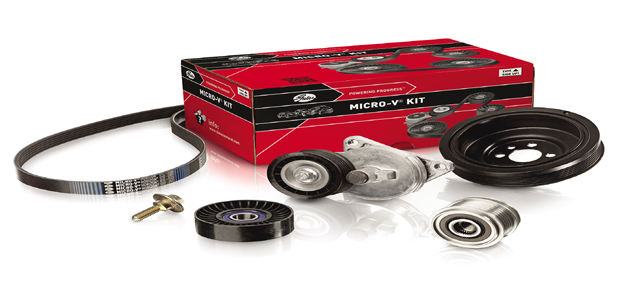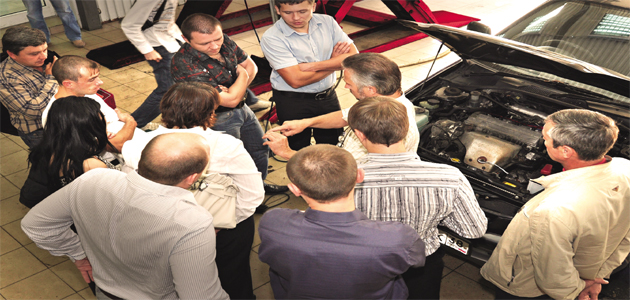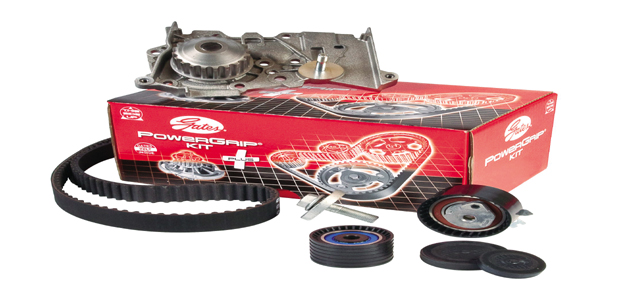
Despite the added expense to the job, most garages now accept the need to install timing belt kits, rather than just the belt. Current estimates indicate that at the scheduled change, Synchronous Belt Drive Systems (SBDS) kits are installed 90% of the time.
Gates has stepped up its campaign to include water pumps as well, by extending its PowerGrip Kit Plus Water Pump range. This has prompted mechanics attending recent Gates technical workshops to ask a few questions in relation to SBDS and Auxiliary Belt Drive Systems (ABDS) kits:
Q. There are a lot of components in the ABDS – how can I justify the cost of replacing them all when there’s only a problem with one of them?
A. .Wear to any one of these components can adversely affect the performance of others. The ABDS in the latest cars supply the drive for an alternator, the power steering pump, an A/C compressor and, sometimes, the water pump. Note the presence of the safety critical item – the power steering.
The ABDS itself usually includes a multi-ribbed belt, a tensioner, an idler, a torsional vibration damper (TVD) and an overunning alternator Pulley (OAP). The use of EPDM (the chemical abbreviation) to construct most belts makes it impossible to judge the wear to the belt from a visual check. Secondly, most mechanics now accept the need to replace the multiribbed belt, the tensioner and the idler at the same time.

However, they raise eyebrows about the simultaneous replacement of the TVD and the OAP. TVDs are crankshaft pulleys that contain a rubber-damping element. It helps improve the NVH (noise, vibration and harshness) characteristics of the drive. Designed to operate in high temperatures and absorb vibration, TVDs are subject to wear as the rubber can become loose and harden, crack or lose its elasticity with age.
The TVD has also been known to break free from the engine. What’s more, wear is not always obvious from an inspection, while its symptoms (increased vibration) are often misdiagnosed and attributed to the belt, idler or OAP. Note the reference to a misdiagnosis as replacing a worn tensioner to fix vibration issues may cure a symptom, but not necessarily the cause.
A worn TVD can also increase vibration, causing premature wear of the new tensioner. In this case the TVD, rather than the tensioner, may have been the cause. OAPs are the OE response to the expansion of on-board comfort and leisure accessories that draw extra electrical power.

The OAP allows the alternator to ‘freewheel’ or ‘overrun’ under deceleration, while dampening the vibrations generated; however, they can seize and lose their dampening ability. This would increase vibration and lead to premature belt failure.
However, there are different types of OAP and they’re not interchangeable. Supplying them from a kit is the easiest and most practical solution.
Q. If I’ve checked the water pump and it seems OK, why should it be changed now when it could run happily for another few years?
A. If the waterpump is the OE fitment, it was installed when the belt and tensioner(s) were new. So, the old water pump will now run off the new belt and metal parts you are about to install. If it fails a short time after the kit replacement, the cost of replacing the engine is at stake. Who pays?
The convincing argument that supports the case for change is that standard times for installing kits, as well as a new water pump, are usually the same as for the standard kit alone. If the customer has already paid for the labour, it makes sense to fit the new water pump, too, to add value for money. For that little extra, the SBDS has been completely overhauled.

So, all of the parts are new. If they are from the same kit, you can a) guarantee they are the correct parts and b) have the protection of a warranty from one supplier.
Summary
In both of these cases Gates believes that SBDS and ABDS kits provide the best solution because the result is a complete overhaul of the drive system. The added expense argument can be countered in both instances with the same riposte: ‘Which is more expensive – installing the kit or replacing the engine?’









